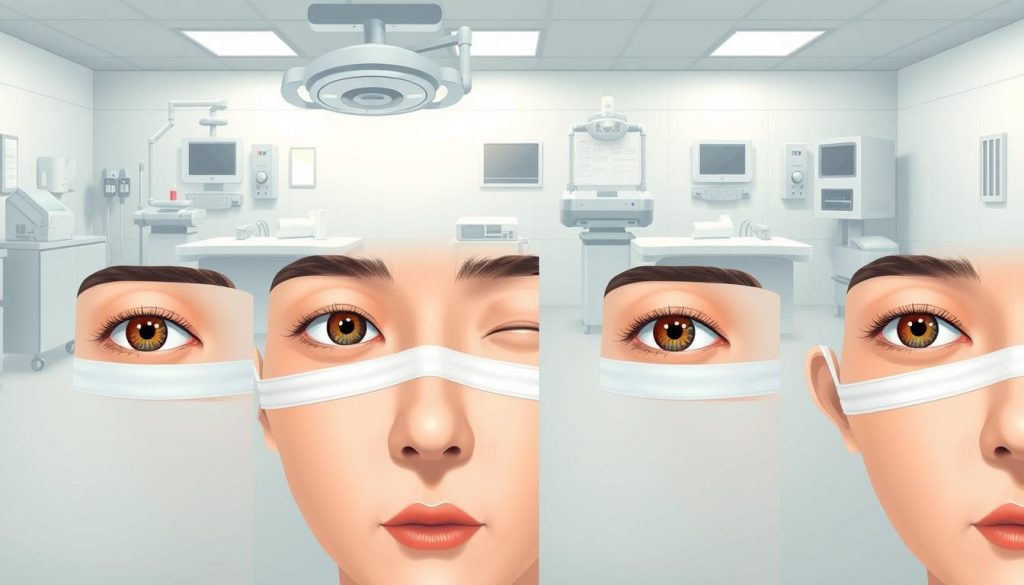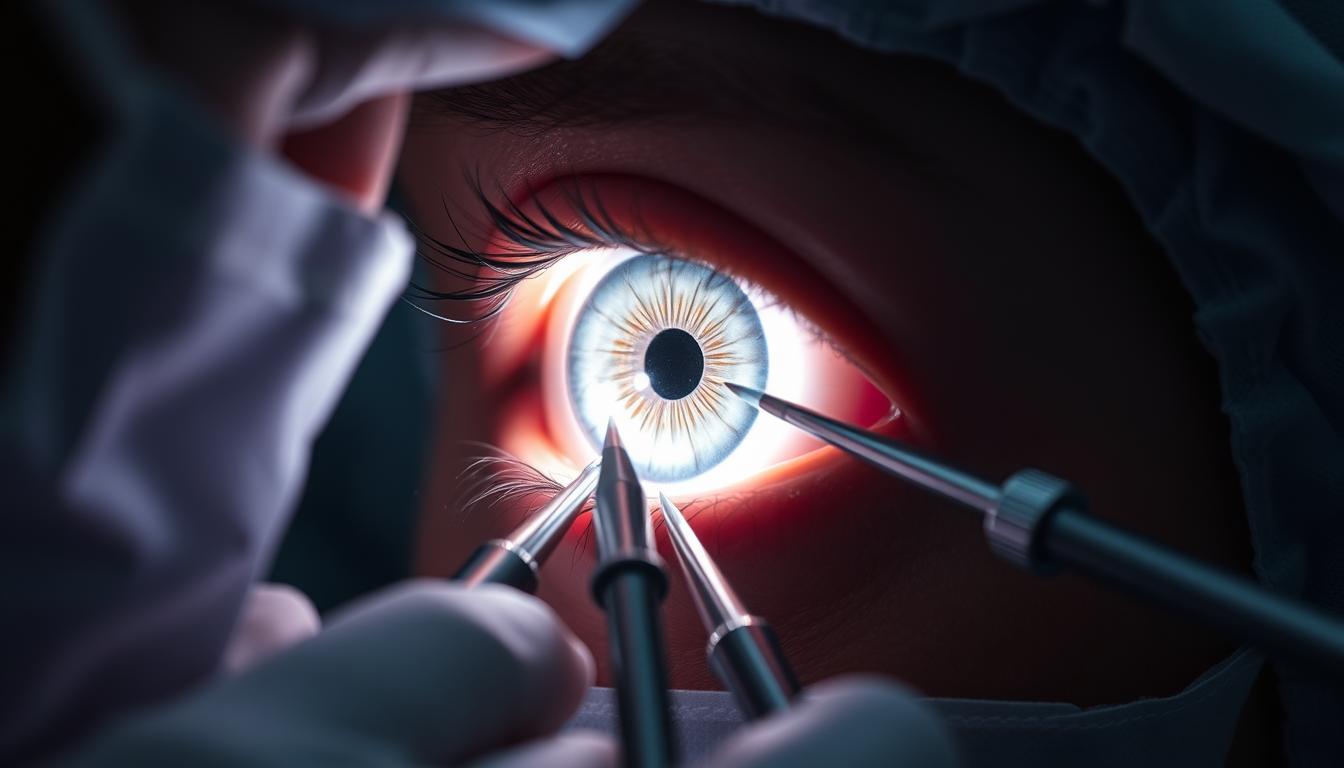Enhancing the appearance of the eyes has become a significant aspect of cosmetic procedures, with double eyelid surgery being one of the most sought-after operations.
The field of plastic surgery has advanced significantly, particularly in procedures related to the eye. Korean plastic surgery has gained international recognition for its sophisticated techniques and natural-looking results, especially in surgery to enhance the eye‘s appearance.
This comprehensive guide will delve into the various types of procedures available, including non-incision and incision methods, as well as anti-aging treatments. Understanding the benefits, risks, and recovery processes is crucial for individuals considering these surgical interventions.
Key Takeaways
- Double eyelid surgery creates an eyelid crease, resulting in a larger and more symmetric eye.
- Korean plastic surgery is renowned for its advanced techniques and natural-looking results.
- Various procedures are available, including non-incision and incision methods.
- Understanding the benefits and risks is essential for potential patients.
- The recovery process varies depending on the type of surgery.
Understanding Korean Eye Surgery

Korean eye surgery encompasses a range of procedures aimed at enhancing the appearance of the eyes. These eye surgery procedures, refined by Korean plastic surgeons, primarily focus on creating or enhancing the upper eyelid crease, a feature naturally absent in approximately 50% of East Asian individuals.
The surgeries are customized based on individual preferences and anatomical considerations. For instance, individuals of North Eastern descent typically prefer a smaller eyelid height ranging from 3-6 mm, while those from South Eastern descent may prefer a taller eyelid height, ranging from 7-10 mm.
The Popularity of Double Eyelid Surgery
Double eyelid surgery has gained immense popularity in East Asia, particularly in Korea, where it is considered a staple in cosmetic procedures. This procedure’s popularity stems from its ability to create a more defined eye appearance while maintaining natural-looking results that complement Asian facial features.
The combination of double eyelid surgery with complementary procedures like epicanthoplasty has further increased its popularity by offering comprehensive eye enhancement. A plastic surgeon can perform this procedure to create double eyelids, enhancing the overall appearance of the eyes and eyelids.
Types of Korean Eye Surgery Procedures
The variety of Korean eye surgery procedures allows patients to choose the most suitable option for their needs. Korean eye surgery is renowned for its advanced techniques and aesthetic outcomes.
Non-Incision Method
The non-incision method is a popular technique used in Korean eye surgery, particularly for double eyelid surgery. This method involves making minimal punctures rather than incisions, resulting in less scarring and a quicker recovery.
It is ideal for patients seeking a subtle, natural-looking enhancement.
Incision Method
The incision method, on the other hand, involves making a small incision in the eyelid to create a double eyelid or to remove excess skin and fat. This method is more invasive but provides long-lasting results.
It is often recommended for patients with thicker eyelids or those who desire more pronounced results.
Anti-Aging Eye Surgery
Anti-aging eye surgery focuses on rejuvenating the appearance of the eyelids and surrounding area. Procedures like upper blepharoplasty remove excess skin and tissue, creating a more defined and youthful look.
Anti-aging eye surgery can also improve vision by removing obstructing eyelid skin. Complementary procedures like sub-brow lifting or forehead endoscope surgery can enhance the overall rejuvenation effect.
Benefits of Korean Eye Surgery
The benefits of Korean eye surgery extend beyond cosmetic improvements, offering functional advantages as well. Korean eye surgery offers both aesthetic and functional benefits, enhancing the appearance of the eyes while potentially improving vision in cases of obstructive eyelid skin.
Modern treatments minimize scarring by placing incisions within natural creases or using non-incision methods that leave virtually no visible marks. The procedures can create a more defined eye shape and crease, resulting in eyes that appear larger, more symmetrical, and more expressive.
- Minimize the incision near to the eyelashes for minimal scarring.
- Reduce or remove eye bags, wrinkles, loosened, and sagging skin.
- Create a fresh and young image through successful double eyelid surgery, leading to a satisfying result.
By addressing both aesthetic and functional concerns, Korean eye surgery provides a comprehensive solution for individuals seeking to enhance their eye shape and overall eye health.
Ideal Candidates for Korean Eye Surgery
Candidates for Korean eye surgery include individuals with monolids or asymmetrical eyelids. These people often desire a more defined eye appearance. Ideal patients are those in overall good health, with realistic expectations about the outcomes.
- Individuals with monolids who desire a more defined eye appearance.
- Patients with asymmetrical eyelids or excess upper eyelid skin.
A patient seeking natural-looking results with minimal recovery time may be better suited for the non-incision method. Candidates should be prepared to follow post-operative care instructions diligently.

The Korean Eye Surgery Procedure
Understanding the specifics of Korean eye surgery is crucial for individuals considering this cosmetic procedure. The surgery may vary depending on the technique and individual patient needs.
Non-Incision Method Steps
The non-incision method involves several key steps:
Preparation and Design
The surgeon designs the desired double eyelid crease.
Micro Hole Puncturing
Micro holes are punctured along the designed crease line.
Thread Insertion
A thread is inserted through the micro holes to create the double eyelid.
Final Results
The final results are visible once the initial swelling subsides, typically within a few weeks.
Incision Method Steps
The incision method is a more invasive technique that involves:
Design and Anesthesia
The surgeon designs the crease and administers anesthesia.
Incision and Removal
An incision is made, and excess skin or fat is removed.
Suturing
The incision is sutured to create a defined double eyelid crease.
Final Results
The final results of the incision method are generally more permanent and defined.
The time required for Korean eye surgery can vary, but it typically takes around 30 minutes to an hour per eye. It’s essential to note that while initial swelling and bruising are expected, these gradually subside over 2-3 weeks to reveal the final results.
| Technique | Duration | Recovery Time |
|---|---|---|
| Non-Incision | 30 minutes | 1-2 weeks |
| Incision | 1 hour | 2-3 weeks |
Results may vary between individuals based on factors such as skin elasticity, healing capacity, and adherence to post-operative care instructions. The incision method provides long-lasting results that maintain their appearance over time, even as the patient ages.
Non-Incision vs. Incision: Comparison
Korean eye surgery offers two primary approaches: non-incision and incision methods, each with its own set of advantages and disadvantages. The choice between these methods depends on several factors, including the patient’s anatomy and aesthetic goals.
Surgery Time and Procedure
The non-incision method typically involves a shorter surgery time, often 30 minutes or less, with a simpler procedure that doesn’t require an incision. In contrast, the incision method can take longer, sometimes up to an hour, due to the complexity of the procedure.
Recovery Period
Patients who undergo the non-incision method usually experience a faster recovery, with minimal scarring and less downtime. Those who choose the incision method may face a longer recovery period, with potential visible scarring and more pronounced swelling.
Pros and Cons
The non-incision method offers advantages like minimal scarring and a more natural-looking result, but may not be suitable for patients with thick eyelid skin. The incision method provides more dramatic and long-lasting results, but comes with a longer recovery time and potential for visible scarring.
“The choice between non-incision and incision methods should be based on a thorough consultation with a qualified surgeon who can assess the patient’s unique anatomy and aesthetic goals.”
Ultimately, the decision between non-incision and incision methods for double eyelid surgery should be made after careful consideration of the patient’s shape and preferences, as well as the surgeon’s professional advice, to ensure the best outcome for the patients.
Recovery After Korean Eye Surgery
The recovery process following Korean eye surgery is a critical phase that requires careful attention and adherence to post-surgery instructions. Proper care during this period is crucial for achieving the desired outcome and minimizing potential complications.
Post-Surgery Care Instructions
Patients should follow specific care instructions after Korean eye surgery to ensure a smooth recovery. This includes managing discomfort with prescribed pain medication and using cold compresses to reduce swelling. It’s essential to keep the surgical site clean and follow the surgeon’s advice on post-operative care.
Timeline for Recovery
The recovery timeline can be broken down into several stages.
| Days | Recovery Stage |
|---|---|
| 1-3 | Significant swelling and bruising; managed with pain medication and cold compresses. |
| 4-7 | Sutures removed (for incision method); swelling begins to subside. |
| 1-2 weeks | Most patients return to normal activities; strenuous exercise avoided. |
| 3-4 weeks | Visible swelling and bruising resolve; preliminary results apparent. |
| 1-3 months | Final results become apparent as residual swelling subsides. |
Throughout the recovery period, patients may experience varying degrees of swelling and bruising, but by following the surgeon’s instructions, they can have a more comfortable and successful recovery experience. For any concerns or questions, patients are advised to contact their surgeon’s office via email or phone. Over the course of several weeks, the final results of the surgery will become more evident.

Potential Risks and Side Effects
Korean eye surgery, like any other surgical procedure, comes with its own set of potential risks and complications. Patients should be aware of possible side effects, including infection, bleeding, and scarring.
- Infection and adverse reactions to anesthesia are potential risks.
- Specific complications may include asymmetry, visible scarring, and dry eye syndrome.
- Some patients may experience difficulty closing their eyes immediately after surgery.
Choosing a qualified surgeon can minimize risks in the operated area. Additional treatments may be needed to address persistent issues.
Choosing a Qualified Surgeon

When considering Korean eye surgery, it’s essential to choose a surgeon with the right qualifications and experience. Patients should look for board-certified plastic surgeons who specialize in Asian eyelid surgery.
Reviewing before-and-after photos of previous patients with similar eye structures can help assess the surgeon‘s aesthetic style and technical skill. Personal consultations provide an opportunity to evaluate the surgeon’s approach and communication style.
A reputable plastic surgeon will thoroughly explain the procedure, recovery process, and potential risks, ensuring realistic expectations. Checking credentials and reading patient reviews can help identify qualified surgeons.
What to Expect During Your Consultation
A consultation for Korean eye surgery involves a thorough evaluation of your eye anatomy, including the thickness of your skin and the shape of your eyes. During this initial meeting, the surgeon will conduct a comprehensive examination to understand your unique eye structure and identify any functional issues.
The consultation process includes a detailed discussion of your aesthetic goals and expectations to determine whether they can be realistically achieved through surgery. Your surgeon will review your medical history to identify any conditions that might affect your candidacy for surgery or influence the surgical approach.
| Consultation Aspect | Description |
|---|---|
| Eye Anatomy Examination | Evaluation of skin thickness, eye shape, and functional issues |
| Aesthetic Goals Discussion | Understanding the patient‘s expectations and determining realistic outcomes |
| Medical History Review | Assessing medical conditions that may impact surgery or recovery |
Your surgeon will explain the different surgical options available, recommending the most appropriate technique based on your unique anatomy and desired outcome. Before-and-after photos of previous patients with similar eye structures may be shown to provide a realistic understanding of potential results. The consultation should include a comprehensive discussion of the recovery process, potential risks, and expected outcomes to ensure you can make an informed decision about undergoing Korean eye surgery.
Making an Informed Decision About Korean Eye Surgery
With its growing popularity, Korean eye surgery is becoming a significant consideration for many individuals seeking to enhance their appearance. Making an informed decision about this plastic surgery requires careful consideration of personal motivations and expectations.
Patients should have realistic expectations about what the surgery can achieve. It’s also crucial to consider the financial investment, as Korean eye surgery is typically not covered by insurance when performed for cosmetic purposes in this area.
Some people find it helpful to speak with previous patients who have undergone similar procedures. Ultimately, the decision to undergo surgery should be made for personal satisfaction, supported by a qualified surgeon who provides comprehensive information without pressure, helping people feel comfortable with their choice.
FAQ
What is the typical recovery time for double eyelid surgery?
The recovery time may vary from person to person, but generally, patients can expect to return to their normal activities within a few weeks. Swelling and bruising typically subside within a couple of weeks.
What type of anesthesia is used for eyelid surgery?
Local anesthesia with sedation is commonly used for eyelid surgery, allowing patients to remain comfortable during the procedure. The type of anesthesia used may vary depending on the individual’s needs and the surgeon’s preference.
Are there any potential risks or side effects associated with eyelid surgery?
As with any surgical procedure, there are potential risks and side effects, including inflammation, scarring, and asymmetry. However, when performed by a qualified surgeon, these risks are minimized, and the results are generally safe and effective.
How long does the eyelid surgery procedure take?
The duration of the procedure can vary, but it typically takes around 30 minutes to an hour to complete, depending on the complexity of the case and the method used.
Is it necessary to remove stitches after eyelid surgery?
The need for stitch removal depends on the type of procedure performed. Some methods, such as the non-incision method, may not require stitch removal, while others may necessitate it.
Can anyone undergo double eyelid surgery?
Not everyone is a suitable candidate for double eyelid surgery. Ideal candidates are those with a good overall health status and realistic expectations. A consultation with a qualified surgeon is necessary to determine suitability for the procedure.
What are the benefits of choosing a qualified plastic surgeon for eyelid surgery?
A qualified plastic surgeon can ensure a safe and effective procedure, minimizing the risk of complications and achieving the desired results. They will also provide personalized care and guidance throughout the process.
How can I care for my eyelids after surgery?
Post-surgery care instructions will be provided by the surgeon, but generally, patients are advised to keep the area clean, avoid strenuous activities, and follow a specific timeline for recovery.
